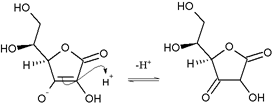In poor rural Mexican communities, 80-85% of the population consumes a diet based on maize tortillas, beans, green vegetables, and fruit. In the typical Mexican rural diet, <64% of the total energy comes from carbohydrates, maize provides 40% of the total protein and 45% of the energy, and the intake of meat, fish, and poultry is very low. This type of diet is associated with poor iron bioavailability, anemia, and deficiencies of iron and other micronutrients. In rural Mexico, iron deficiency affects 10-70% of individuals in different age and population groups, although iron intake overall is higher than recommended. A potential approach to improving iron status is to make iron more available for absorption. Ascorbic acid (AA) is the main dietary enhancer of iron absorption apart from meat, fish, and poultry, but the intake of AA-rich foods is low in rural Mexico. The median AA intake of 33 mg/d in non-pregnant, non-lactating (NPNL) women is derived from the locally produced alcoholic beverage pulque (a lime beverage known as agua de limon), red and green tomatoes, potatoes, chili peppers, wild greens, cactus, other citrus fruit, and mangoes when in season.
Pulque is the main source of AA for NPNL rural Mexican women in the present study, as well as the third most important source of nonheme iron. The amount of pulque consumed is the main predictor of a lower risk of anemia and iron deficiency. There are no reported long-term, community-level efficacy trials of the effects of adding AA from local food sources to meals high in poorly available, nonheme iron. The current study reports the long-term (8 months) effect of increasing AA intake from agua de limon on the iron status of iron-deficient, rural Mexican women by using a dose that had first been proven, with the use of iron isotopes, to double iron absorption in similar women.
Two rural Mexican populations were randomly assigned to an AA or a placebo group, each with 18 iron-deficient women. The AA group was given 500 ml limeade containing 25 mg AA twice a day, 6 d/wk, for 8 months. The placebo group was given a lime-flavored beverage free of AA or citric acid. Beverages were consumed within 30 min of two main daily meals. Data were collected on morbidity (3 times/wk), dietary intake (on 6 d), socioeconomic status, parasites (twice), medical history, and response to treatment. Blood samples at 0, 2, 4, 6, and 8 months were analyzed for hemoglobin, plasma AA, plasma ferritin, transferrin receptors, and C-reactive protein.
AA intake was significantly higher in the AA group, but nonheme iron, heme iron, and phytic acid intakes did not differ significantly. Plasma AA was significantly higher in the AA group at 2, 4, 6, and 8 months. There were no final differences between groups in hemoglobin, plasma ferritin, or transferrin receptor concentrations or in the ratio of transferrin receptors to plasma ferritin after control for initial concentrations. Increasing dietary AA by 25 mg at each of thetwo meals/d did not improve iron status in iron-deficient women consuming diets high in phytate and nonheme iron. The lack of improvement in iron stores was not due to noncompliance or failure of the intended intake of AA. Women in both communities had a high intake of nonheme iron and phytate, and the subjects consumed the limeade with the meals that were highest in iron and phytate. No parasites were detected that could interfere with iron absorption. It is therefore probable that other factors had a stronger influence on iron status than did AA intake. Although there was no significant difference in the measured intakes of nonheme or heme iron between the groups, the researchers had no control over the subjects diets except for the dose of AA.
The results of this study do not necessarily mean that increased AA intake should not be encouraged. There are several situations in which higher intakes of the vitamin would likely improve iron status. One is a situation in which meals contain substantial amounts of fortifying iron, at least in the form of ferrous sulfate. It has been estimated that a 6:1 (by wt) ratio of AA to iron is required to usefully increase the absorption of soluble nonheme iron, whereas a ratio closer to 12:1 may be needed if the foods are high in phytic or phenolic acid, as they are in rural Mexico. The ratios in this study were 10:1 in the AA group and 5:1 in the control group. The effect of AA on iron absorption is dose related. In conclusion, increasing AA intake as limeade did not improve the iron status of iron-deficient women consuming diets high in phytate and nonheme iron in rural Mexico. Because of the lack of efficacy and the paucity of local food sources that can adequately increase AA intake, the researchers conclude that this food-based intervention is not practical or effective for improving the iron status of women in these communities, at least once they already have become iron depleted. Iron fortification or supplementation is required. It is possible, however, that AA could produce a detectable increase in iron stores in some other situations.
O Garcia, M Diaz, J Rosado, L Allen. Ascorbic acid from lime juice does not improve the iron status of iron-deficient women in rural Mexico. Am J Clin Nutr 78:267273. (August 2003) [Correspondence: LH Allen, Department of Nutrition, Meyer Hall, One Shields Avenue, University of California, Davis, CA 95616-8669. E-mail: lhallen@ucdavis.edu.]
COPYRIGHT 2003 Frost & Sullivan
COPYRIGHT 2003 Gale Group



